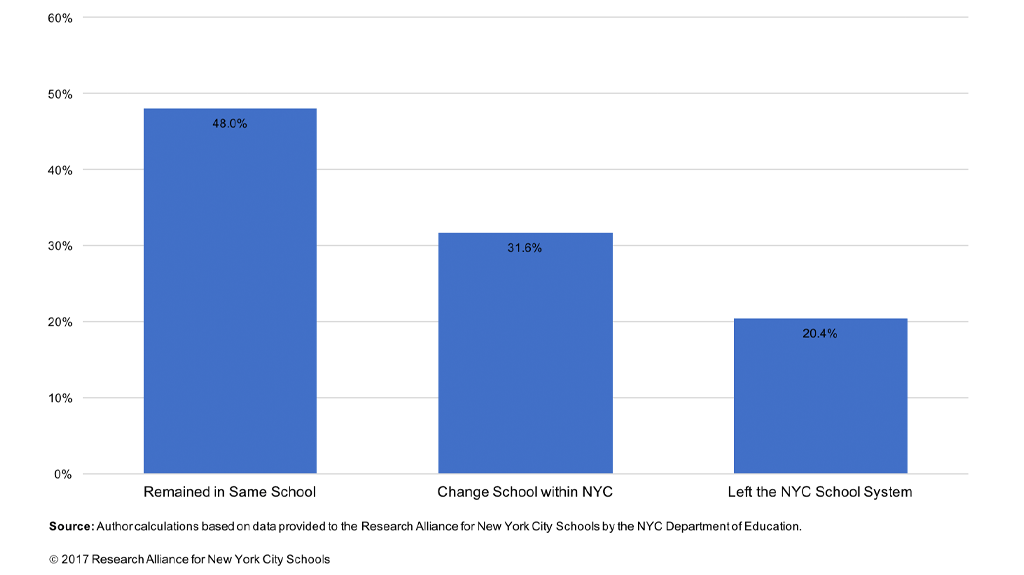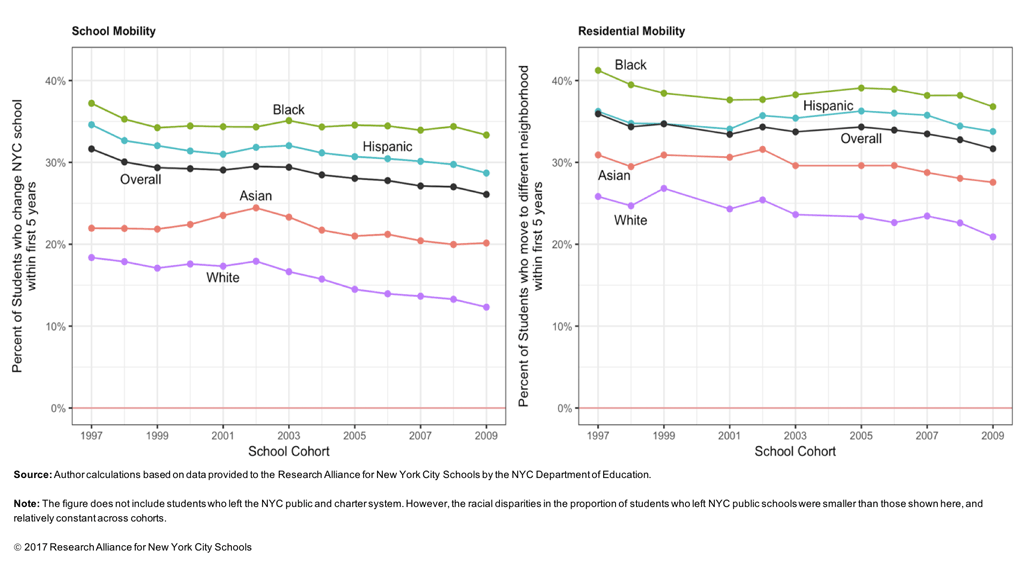The movement of students from school to school—which researchers refer to as “mobility”—is pervasive across urban school districts in the United States. For mobile students, changing schools and neighborhoods can disrupt the learning process. For schools, high student turnover can undermine efforts to build a cohesive and supportive community. The negative consequences of mobility have been a persistent concern among educators and researchers alike.[1]
As part of a larger forthcoming study, we looked at trends in student mobility, and how these trends vary for different subgroups of students. We examined multiple cohorts of NYC students who entered 1st grade for the first time, in a public or charter school, between 1997 and 2009. We followed these students over the next five years (i.e., until their scheduled 5th grade year).[2]
For the 1997 cohort, we found that only about half of all students (48%) remained in the same school for the five years after they enrolled in first grade (see Figure 1). It should be noted that most NYC elementary schools include grades 1-5, so there is no compulsory or expected transfer in these years (as in from elementary to middle or from middle to high school).
So, what about the other half of students? Almost one third (32%) of those in the 1997 cohort changed schools within the NYC system at least once in their first five years, and nearly 11 percent transferred multiple times within NYC. An additional 20 percent left the NYC public or charter school system entirely.
Figure 1: School and Residential Mobility for the 1997 First-Grade Cohort

Over the same period, 36 percent of students moved to a different neighborhood within NYC.[3] In many cases, residential and school mobility overlapped. We found that in 65 percent of cases when families moved, children also transferred to a different school. Similarly, 64 percent of school changes were related to residential moves.
When we look at multiple cohorts, we see that over the last decade school mobility within NYC has continuously declined. It fell from about 32 percent for the 1997 cohort to 26 percent for the 2009 cohort. Over the same period, we observe a similar decrease in the proportion of students who left NYC public schools and a smaller but still noticeable decrease in residential mobility within NYC.
As shown in Figure 2, the overall patterns for school and residential mobility vary for different racial and ethnic subgroups:
Figure 2: School and Residential Mobility Within NYC by Race, 1997 – 2009 First-Grade Cohorts

These findings indicate that racial disparities in school mobility within NYC are large and increasing over time.[4] For example, compared to their White peers, Black students in the 1997 cohort were twice as likely to change schools in the five years after enrolling in first grade. This disparity rose to 2.7 times more likely for the 2009 cohort. There were also large racial disparities for residential mobility, with a more modest increase over time. Over 40 percent of Black students from the 1997 school cohort moved to a different neighborhood, compared with 26 percent of White students, a 1.6 times higher rate. This difference increased to 1.8 for the 2009 cohort.
Big Questions
The pervasive nature of school and residential mobility and the increasing racial disparities raise several important questions:
- Why are students changing schools? To what extent are various factors, such as homelessness, job loss, divorce, or the desire to attend a better school, driving mobility?
- Are students generally moving to higher- or lower-quality schools?
- Why have racial disparities in mobility increased, even as overall mobility has gone down?
- What is the effect of mobility on student performance, and what are the consequences for educational inequality?
- How does mobility interact with the influence of neighborhoods, schools and peers? Previous research on these effects largely ignores the role of changes in family residence and related school transitions. In an ongoing study, we are looking closely at students who change schools, to understand if they are more or less susceptible to the influence of their peers in the years following that change.
What else should we be asking about student mobility in NYC public schools? Are you exploring any of these topics? Let us know via email.
This post was authored by Joscha Legewie, assistant professor of sociology at Yale University, using data provided to the Research Alliance for New York City Schools by the NYC Department of Education.
Footnotes
[1] See Grigg, Jeffrey. 2012. “School Enrollment Changes and Student Achievement Growth: A Case Study in Educational Disruption and Continuity.” Sociology of Education 85(4):388–404 and Beatty, Alexandra. 2010. Student Mobility: Exploring the Impact of Frequent Moves on Achievement: Summary of a Workshop. National Academies Press.
[2] On average, each cohort included around 78,000 students; the biggest cohort entered first grade in 1997 (91,956 students) and the smallest started in 2008 (70,862 students).
[3] Note that the rate for residential mobility excludes students who left the NYC public school system, as we do not have data about residential addresses for students who are no longer enrolled in NYC public schools.
[4] The racial disparities in the proportion of students who left NYC public schools (not shown in Figure 2) were small and relatively constant across cohorts (not shown in figure).
How to Cite this Spotlight
Legewie, J. 2017. "Have Students Become More or Less Likely to Change Schools?" Spotlight on NYC Schools. Research Alliance for New York City Schools.
